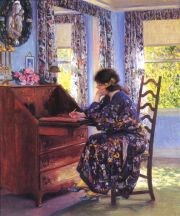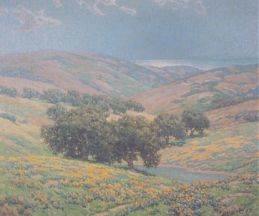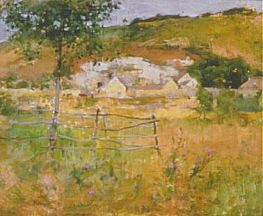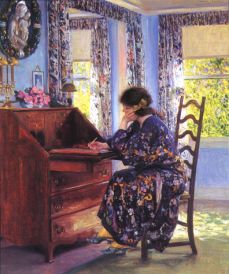These paintings, which span the years of 1885-1930, are evocative, nostalgic, even romantic. The French may have invented Impressionism, but several American artists took this form and made it uniquely their own. You will see works by Guy Rose, Granville Redmond, Theodore Robinson, Theodore Butler, Willard Metcalf and Childe Hassam.
The first major exhibition of Impressionism took place in New York City in 1886 when more than 300 Impressionist paintings were unveiled. After the Civil War, numbers of painters left the United States to study in Europe, particularly France. The didn't go to study Impressionism per se, but they picked up new ideas once they got there.
"Impressionism is popular today because it covers a period of time we can relate to," said Jan Driesbach, Crocker curator. "These exquisite paintings bring together Impressionists from throughout the country and internationally. We are fortunate in this exhibit to have a number of major loans from private collectors outside the area. These are pieces we would otherwise not have the opportunity to view."
 "The Difficult Reply" by Guy Rose (1867-1925), painted in about
1910, features a woman sitting at her desk trying to write a letter
that's not coming easily. The woman's elegant kimono, the chintz curtains,
the light coming in the windows, all combine to form a beautiful picture
that the Crocker uses to illustrate its brochure describing the exhibit.
"The Difficult Reply" by Guy Rose (1867-1925), painted in about
1910, features a woman sitting at her desk trying to write a letter
that's not coming easily. The woman's elegant kimono, the chintz curtains,
the light coming in the windows, all combine to form a beautiful picture
that the Crocker uses to illustrate its brochure describing the exhibit.
Driesbach characterizes "The Difficult Reply" as a "drop-dead gorgeous painting."
"(Rose) receives Impressionism through the template of Monet," she added as she guided visitors through the exhibit. Rose studied in Paris and in 1894 bought a home in Giverny, where Claude Monet lived.
Many Americans who studied painting abroad made the pilgrimage to Giverny including Theodore Robinson (1852-1896) who lived next door to Monet from 1888 to 1892. His 1892 painting, "La Debacle," is included in the exhibit. Look closely and you might be able to tell that Robinson painted his canvas white before he began painting over it in pastel colors. The underlying white adds a richness and intensity.
"Monet never took students," said Driesbach. But if you moved to his town and painted you were likely to meet him, as Robinson did.
"La Debacle" (the title of a book of the day by Emile Zola) shows a young model named Marie sitting near a bridge on the Epte River who has apparently been interrupted by a person or incident outside the canvas to the left. Robinson may have admired Monet, but he didn't want to give up the hard-won techniques he'd mastered studying art.
"Americans struggled for their art training," said Driesbach. "Robinson may respond to Monet's work, but there are differences, too. Robinson's painting is solid, unlike the little quick strokes of Monet, and the human figure is more solid that the background that surround it."
Monet apparently saw this painting and liked it, commenting on it favorably. Robinson was for a time a conduit of Impressionism to the United States but he was not to enjoy his success for long. He died of a violent asthma attack at age 43.
Another American who traveled to Giverny and was friends with both Guy Rose and Theodore Robinson was a man named Theodore Butler. Like the others before him, he went to France originally to study at the academy and was drawn to Giverny to study Impressionism. The fact that the great master Monet didn't take pupils didn't slow Butler down at all. He married Monet's stepdaughter, Suzanne, and when Suzanne died he married her sister.
His "Bridge at Giverny" (1905) is the most like a Monet in the blue and green colors, the local outdoor subject matter, and the quick brushwork.
 Driesbach says that Guy Rose and Granville Redmond (1871-1935) are the two
finest American Impressionists in the exhibit. So be sure to look not only
at Rose's "The Difficult Reply" but at Redmond's "Poppies and Lupines, Marin
County." This painting of a valley covered in wildflowers, stretches off to
the ocean. You can get lost in it.
Driesbach says that Guy Rose and Granville Redmond (1871-1935) are the two
finest American Impressionists in the exhibit. So be sure to look not only
at Rose's "The Difficult Reply" but at Redmond's "Poppies and Lupines, Marin
County." This painting of a valley covered in wildflowers, stretches off to
the ocean. You can get lost in it.
Redmond became deaf at age 2. He grew up in Berkeley. And even though he studied painting in Europe, the California coast was his favorite subject.
"His paintings have a sense of quietude, perhaps evidence of the silent world he occupied," said Driesbach. "Thankfully for us, he had a fascination with wildflowers."
 Willard L. Metcalf (1858-1925) demonstrates great versatility as an
Impressionist, first with the warm summer "Auberge, Road to Giverny" (1887)
then with the chilly winter scene of "The Winter's Festival" (1913). It's
said that Metcalf went to elaborate lengths to paint outside in the cold, a
season most Impressionists ignored, preferring to paint under less
challenging conditions.
Willard L. Metcalf (1858-1925) demonstrates great versatility as an
Impressionist, first with the warm summer "Auberge, Road to Giverny" (1887)
then with the chilly winter scene of "The Winter's Festival" (1913). It's
said that Metcalf went to elaborate lengths to paint outside in the cold, a
season most Impressionists ignored, preferring to paint under less
challenging conditions.
But among the factors that contributed to the popularity of Impressionism at the turn of the century were popular outdoor painting classes held in many parts of the country.
Childe Hassam (1859-1935) was considered one of America's foremost Impressionists, following the death of Theodore Robinson. "An Outdoor Portrait of Miss Weir" (1909) is evocative of Renoir in subject and color. Hassam explored contemporary urban subjects, too, but in this portrait he is chiefly interested not in portraying the personality of the sitter but in the interplay of light and shadow. And, again, unlike the French Impressionists, he keeps the figure of the woman solid, not dissolving it into light.
"Miss Weir," the daughter of a friend, is typical of the refined upper-class women found in paintings at this time by artists working in Boston and New York. Fashionably dressed in white, she appears immobile and aloof, turning her gaze away from the viewer, much like the woman in Guy Rose's painting.
The Crocker always makes available for sale a representative print from each exhibit at a price anyone can afford and for this exhibit "An Outdoor Portrait of Miss Weir" was chosen. You can buy this print for $5 at the Crocker gift shop. It's an excellent reminder of a special exhibit.
